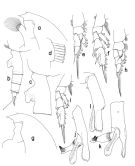|
|
 |
Fiche d'espèce de Copépode |
|
|
Calanoida ( Ordre ) |
|
|
|
Clausocalanoidea ( Superfamille ) |
|
|
|
Euchaetidae ( Famille ) |
|
|
|
Paraeuchaeta ( Genre ) |
|
|
| |
Paraeuchaeta eminens Tanaka & Omori, 1968 (F,M) | |
| | | | | | | Syn.: | Pareuchaeta eminens Tanaka & Omori, 1968 (p.235, Descr.F, figs.F);
Euchaeta eminens : Park, 1978 (p.268, figs.F) | | | | Ref.: | | | Bradford & al.,1983 (p.38, figs.F, Rem.); Park, 1994 (p.320); 1995 (p.59, Rem.F, Descr.M, figs.F,M) |  issued from : T. Park in Antarctic Res. Ser. Washington, 1978, 27. [p.269, Fig.110]. As Euchaeta eminens. Female (from Tasman Sea): A, forehead (lateral); B, C, D, distal end of metasome and genital segment (left side, right side, and ventral, respectively); E, outer lobe of Mx1; F, P1; G, P2. P1-2: legs (anterior).
|
 issued from : T. Park in Bull. Scripps Inst. Oceanogr. Univ. California, San Diego, 1995, 29. [p.162, Fig.52]. Female: a, forehead (left side); b, urosome (left); c, genital somite (left); d, outer lobe of Mx1; e, P1 (anterior); f, P2 (anterior). Nota: Laterally, rostrum roughly triangular with wide base, pointing nearly downward; its anterior margin continuing almost syraight up to suprafrontal sensilla. Dorsal wall of genital somite smooth and only slightly curved. Genital flange with somewhat emarginate ventral margin, about parallel to long axis of body, and produced distally into an extraordinarily large lobe. Posterior edge of genital field produced distally into a relatively small ridge followed by ery short posterior margin of genital prominence about 1/6 length of posterior ventral wall of somite. Cephalosomal appendages similar to those of P. malayensis except that outer lobe of Mx1 with 7 long setae and a minute seta proximally. Swimming legs similar to those of P. malayensis except in P1 exopod, outer spine of 2nd segment a little short of reaching base of following outer spine; in P2 exopod, 2nd outer spine of 3rd segment far short of reaching base of following outer spine and about as long as outer spine of 2nd segment. Male: g, forehead (left); h, P1 (anterior); i, P2 (anterior); j, distal exopodal segments of left 5th leg (anterior, tilted clockwise); k, idem (medial, tilted counterclockwise); l, second exopodal segment of left 5th leg (anterior).
|
 issued from : O. Tanaka & M. Omori in Publs Seto Mar. Biol. Lab., 1968, XVI (4). [p.236, Fig.10]. As Pareuchaeta eminens. Female: A, last thoracic segment and genital somite (part.) (lateral left side); B, genital complex (ventral); C, endopod and 2nd basal segment of Mx1; D, outer lobe of Mx1; E, exopod of P1; F, exopod of P2. Nota: The urosome segments and furca are in the proportional lengths as 44:22:20:4:10 = 100. Prosome and urosome are in the proportional lengths as 71 to 29. Nota from Bradford & al; (1983, p.38): - P1 exopod female: Aa minute; Bb = 5/6 BC; Cc > BC; - P2 exopod female: Aa = Ab; Bb = 3/4 BC; Cc = 3/4 CD; Dd = 1/4 CD. (see code of lengths outer spines in the Genus' figure, or in Paraeuchaeta sp. A).
|
 Paraeuchaeta eminens Paraeuchaeta eminens Female: 1 - See key to species Groups and independent species of Paraeuchaeta (p.30): malayensis species Group. 2 - Outer spine of 2nd exopodal segment (or the 2nd of the first 2 exopodal segments forming a proximal, compound segment) of P1 normally developed (Fig.52-e). 3 - Outer lobe of Mx1 with 7 long setae in addition to 1 minute seta proximally (Fig.52-d). 4 - Genital somite without a conical process on left side close to anterior base of genital prominence (Fig.52-c). 5 - Dorsally and ventrally, genital somite symmetrical. 6 - Laterally, genital flange with extremely large posterior lobe (Fig.52-c). 7 - Laterally, genital somite with smooth dorsal margin (Fig.52-c).
| | | | | Ref. compl.: | | | Park & Ferrari, 2009 (p.143, Table 8, biogeography) | | | | NZ: | 4 | | |
|
Carte de distribution de Paraeuchaeta eminens par zones géographiques
|
| | | | | | | Loc: | | | Indonesia-Malaysia, China Seas (South China Sea, East China Sea), Japan (Honshu), Coral Sea, Tasman Sea | | | | N: | 4 | | | | Lg.: | | | (3) F: 6,6-5,8; M: 5,6; (63) F: 6,18-6,08; {F: 5,80-6,60; M: 5,60} | | | | Rem.: | Park (1995, p.59) found this species in the East and South China seas, The Malay Archipelago, the Coral Sea, and in the Tasman Sea at 40°S (Park, 1978, p.268). | | | Dernière mise à jour : 27/02/2015 | |
|
|
 Toute utilisation de ce site pour une publication sera mentionnée avec la référence suivante : Toute utilisation de ce site pour une publication sera mentionnée avec la référence suivante :
Razouls C., Desreumaux N., Kouwenberg J. et de Bovée F., 2005-2025. - Biodiversité des Copépodes planctoniques marins (morphologie, répartition géographique et données biologiques). Sorbonne Université, CNRS. Disponible sur http://copepodes.obs-banyuls.fr [Accédé le 02 décembre 2025] © copyright 2005-2025 Sorbonne Université, CNRS
|
|
 |
 |






